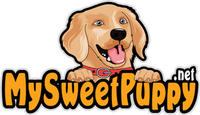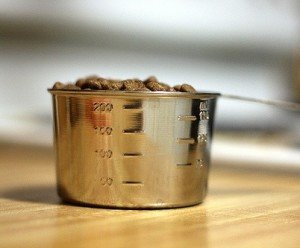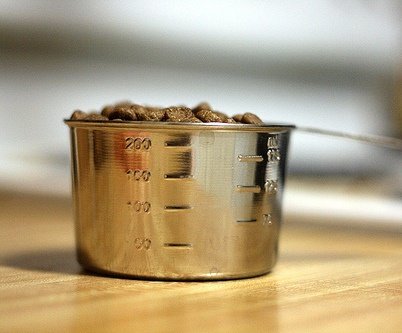Puppies don’t need much to be happy and carefree. Cuddles, food, and exercise will be just about all they require. Of those three needs, food is probably the most complicated factor. But it is not very difficult either, when you begin to understand the dietary needs of a fast-growing puppy.
What food to choose and how much to feed a puppy are your primary concerns. Here are some things to consider that will keep your buddy nourished and happy through these happy first months of life with you.
Ideally you should feed your pup three measured meals a day at regular times. The best times would be about 7am, Noon, and 5pm. An early dinner like this will give your buddy plenty of time to digest the evening meal and use the bathroom before bed. Pups will need to relieve themselves as soon as 20 minutes after eating, so keep this in mind when putting together your doggy’s feeding schedule. For those unable to maintain these hours because of work, an early morning meal and two evening meals, three hours apart, will also work well.
Adhere to the same feeding schedule until your pup is about 14 to 18 weeks old. At this age, your dog should be fed only twice a day.
The meals you give should be a well-balanced and healthy diet that was specially formulated for puppies. Look for quality, protein-rich foods without cheap fillers and other non-puppy-friendly additives. Make sure the food is specially formulated for puppies’ specific dietary needs and to ensure proper growth.
Puppies will need to eat plenty of food to fuel their growing bodies. Don’t worry about a healthy appetite unless your pup is getting too chunky. Obesity is possible even in very young dogs, so make sure your pup isn’t packing on too many pounds. Overfeeding can result in overly accelerated growth in some breeds. To avoid this, make sure your puppy has food formulated for his specific breed size’s nutritional requirements. Also remove any food that he has not eaten after 15-20 minutes and give him a smaller portion next time.
Sometimes it is a good idea to feed a puppy in her crate so that she can enjoy mealtime undistracted. Keeping her confined for 15 minutes after eating will keep her from eliminating waste inside the house. Dogs don’t foul up their crates so even young ones will wait to be let outside before they will use the bathroom in their crate. It is very helpful in potty training to carry puppy from crate to a specific area in the yard so that there is no chance of accident or confusion.
When your puppy is 14-18 weeks old, feeding should be reduced to two daily meals, one in the morning and one in the late afternoon. Two meals a day works better for older puppies of medium and large breeds. Very small breeds can get by with one feeding a day as they grow into adults. A well-fed puppy will grow up happy and strong, providing many healthy years of joy and companionship.

I have lived in big cities my entire life. Having grown up on the Upper East Side in Manhattan, my early life was an exciting one, filled to the brim with interesting encounters and opportunities popping up at every street corner. Like many city people, my passion for dogs first started when my parents decided to bring a puppy into the household. For them, it was a way of getting me to spend less time at his computer or wandering aimlessly around the city with my friends. Little did they know that bringing a Labrador Retriever into their apartment would determine not only the course of their son’s professional career but also my love life.
Having obtained a Computer Science Bachelor’s degree from Fordham University, I went on to pursue an IT career in the Big Apple. After a few years of doing basic cybersecurity and tech support work in various offices around Manhattan, I decided to leave New York and look for my calling in Boston, Massachusetts. There, I got a Master’s degree in Computer Science with a specialization in Web Development. As a means of supporting myself through college, he found a salesman job at a local paper company, where he met Mary, the love of my life and the person I’d end up creating My Sweet Puppy with.





Many puppy owners wonder, “How long should I feed puppy food?” Here is a general timeline for what your puppy needs at each stage of his first year of life.
Why does my shektie puppy only eat from my hand r some of it spilled on the floor instead of her dish
Very good site. thanks
Thanks for connecting to Mysweetpuppy.net. Please keep in mind that I, Claudia Bensimoun, do not write any of the blogs or reviews on this website, nor have I in the past. I only answer the comments section.
Thanks for connecting to Mysweetpuppy.net. Please keep in mind that I, Claudia Bensimoun, do not write any of the blogs or reviews on this website, nor have I in the past. I only answer the comments section.
How many times a day should a 16 week old gsd puppy eat and how much and what food
Thanks for connecting to Mysweetpuppy.net. Please keep in mind that I, Claudia Bensimoun, do not write any of the blogs or reviews on this website, nor have I in the past. I only answer the comments section.
I am in no way connected to the content written within this website, most especially the German Shepherd blog. This website hires other writers for their blogs.Please do not contact me regarding website content. I only write content within the comments section.
German Shepherd pup’s will need to be fed three times a day until 12 weeks of age, and after that twice daily.
• Feed a diet from a well-known, reputable company. Contact them with any questions of concern.
• The labels on any diet should meet the levels established by the AAFCO Control Officials and/ or feeding trials.
• All dog food diets should have the following statement “Animal Feeding tests using the AAFCO procedures substantiate that “Brand X” provides completed and balanced nutrition for growth (or maintenance.)
• Feed puppies puppy food, and be sure to feed a large breed puppy like the German Shepherd a large breed puppy diet.
• Feeding a small dog diet can cause large dogs to grow too quickly, and can lead to serious growth abnormalities and “growing pains.”
Puppy parents need to know that the life stage that a pet food is marketed for, may not be the same life stage for which the food actually meets the minimum requirements.There is no best diet since all dogs have different dietary needs, so it’s always smart to find the best puppy food to match each individual puppy. That said, consult with your veterinarian for advice when changing your German Shepherd’s puppy diet.It’s also wise to examine the nutritional benefits of the puppy food that you’re currently feeding. Jot down all the ingredients, caloric content, protein and fat levels, and question whether your German Shepherd puppy is currently suffering from any health problems like itchy skin, bloat or diarrhea. Your next step will be to find the ideal food for your German Shepherd puppy. German Shepherd pups need lots of attention like all pups.High-quality puppy diets will be important throughout your dog’s life. Maintaining a high-quality diet is most important during puppyhood when your German Shepherd puppy will be growing.
Puppy Feeding Tips
• “Choosing premium brands of dog food made with high quality, easily digestible ingredients is an excellent starting point for ensuring your dog is getting adequate nourishment for his brain as well as his body.It’s also a good idea to switch to healthier treats and supplement foods with cooked sweet potatoes, pumpkin, carrots and green beans. All these provide your dog with extra nutrients.Other human foods that can be shared safely with your dog are lean meats, cooked vegetables and fresh fruits (with the exception of grapes). As long as they do not make up the bulk of your dog’s diet, and you’re not feeding table scraps that contain too much fat, these are nutritious additions and add variety to the diet.” via Animal Wellness.
For more on my article on dog food, visit: https://animalwellnessmagazine.com/brain-food-for-your-dog/
Just like humans, the German Shepherd puppy has to take in enough calories, protein, fat, vitamins, and minerals so that he can grow and develop properly. That said, pups need several feedings throughout the day with only a special formulated puppy food for large breed pups. As the German Shepherd pup gets older, feedings will need to get reduced to twice a day. This continues throughout adulthood, and fresh water needs to be provided at all times. Adding egg, blueberries,and yogurt as toppers to puppy food is also beneficial.
For more about how important breakfast is for both pup and adult dogs,visit https://www.dogrelationsnewyorkcity.com/the-breakfast-effect/
What my supplements can I give my very old Great Dane? She is arthritic
I am in no way connected to the content written within this website, most especially the German Shepherd blog. This website hires other writers for their blogs.Please do not contact me regarding website content. I only write content within the comments section.
Osteoarthritis is a joint disease of which symptoms include lameness,muscle wasting,joint swelling, and thickening with scarring of the joint membrane. According to a study published in Scientific Reports, “Osteoarthritis is typically characterized by progressive degeneration and remodeling of synovial joints, leading to impaired mechanical function of the joint and pain.” via Scientific Reports.”
It is suggested that more than 50% of diagnosed dogs are aged from 8 to 13 years.Although osteoarthritis may begin at any age, it may not be clinically diagnosed until it reaches a more advanced stage with obvious external clinical signs.Many breed types are reported to be predisposed to developing osteoarthritis, particularly larger breeds, which have higher body weights, and purebreds have been considered to be at increased risk of developing osteoarthritis potentially linked to the inherited defects related to conformation of certain breeds.”
The study discusses veterinary management of the dogs diagnosed and adds that ” Eighty-five percent of osteoarthritis cases were managed with at least one clinical modality (medical or surgical treatments) following osteoarthritis diagnosis. Seventy-five percent of cases were recommended an analgesic, of which 77.9% actually received an analgesic drug. Non-steroidal anti-inflammatory drugs (NSAIDs) were the most frequently used analgesic drug group. Surgical interventions were implemented in 4.8% of cases and 4.6% were referred for further treatment and/or investigations overall. Weight loss was recommended in 25.5% and exercise restriction was recommended in 18.8% of cases. At the final available record, 74.3% of cases remained on medical treatment.”
Some Symptoms of Osteoarthritis May Include
.Lameness
.Pain
.Whimpering
.Difficulty jumping up on to couches and beds, even getting in to cars
.Weight gain
.Muscle loss
.Stiffness
That said, it’s best to always consult with your veterinarian for advice, so that your dog can get the correct treatment, and be free of pain. Treatments may include non-steroidal anti-inflammatories to help with pain and inflammation. Sometimes there may be side effects with longterm use like gastrointestinal problems that may include vomiting, loss of appetite, and inflammation of both stomach and intestines. The short term use of corticosteroids helps to suppress inflammation. It is important to follow veterinary follow-ups, and to use all medication prescribed. There are also surgical options that include joint fusion, cutting of the joint,joint replacement, and amputation. Your veterinarian may also suggest weight- loss,and controlled exercise on soft surfaces, so that there is little impact on joints. Warm compresses on the joints help as well. To prevent the cartilage from further degradation, your veterinarian may use joint-fluid modifiers and hydrotherapy. Acupuncture may also help.Joint inflammation tends to affect older dogs, but younger animals are affected as well. Inflammation anywhere in the body may lead to other serious health problems in pets.
Supplements that contain chondroitin sulphate and glucosamine also tend to help in conjunction with veterinary treatments.
Thanks for connecting to Mysweetpuppy.net. Please keep in mind that I, Claudia Bensimoun, do not write any of the blogs or reviews on this website, nor have I in the past. I only answer the comments section.
My puppy is overweight.. what can I do?
I am in no way connected to the content written within this website, most especially the German Shepherd blog. This website hires other writers for their blogs.Please do not contact me regarding website content. I only write content within the comments section.
Regular exercise combined with a high-quality puppy formula is key to maintaining good weight management. That said, consult with your veterinarian, so as to discuss your pup’s specific needs.
Dog breeds like the Labrador, Dachshund, English Bulldog, and Mastiff may be prone to weight issues. When opting for high-quality puppy or dog food diets, here’s what to look out for:
.Look for ingredients that your veterinarian has recommended
.Lean meats from salmon, duck, turkey and chicken with added fruits and veggies that are similar to our own diets
.Opt for formulas that don’t contain artificial colors,flavors, or preservatives
.Opt for formulas that contain probiotics, digestive enzymes, and a healthy amount of fiber
.Choose only quality animal proteins that contain nutrient dense formulas with less caloric density
.Opt for only high-quality dog foods that have had consistently good reviews over the past couple of years
.Check for past and present recalls
.Consider adding supplements that have been recommended by your veterinarian
.Read the food labels/ingredients list often to make sure that nothing has changed
.The first five ingredients should be in descending order, as to the weight of each ingredient listed, with the first ingredient being the one that is present in the highest amount.
Why Dogs Should Exercise Regularly?
.Regular exercise helps maintain a healthy weight
.Increase exercise for weight loss
.Choose a dog sport like agility or canine surfing
.Stretch out with your pooch with a doga class
.Consider raw-inspired and grain-free recipes (FDA warning below)
“The U.S. Food and Drug Administration (FDA) is alerting pet owners and veterinary professionals about reports of canine dilated cardiomyopathy (DCM) in dogs eating certain pet foods containing peas, lentils, other legume seeds, or potatoes as main ingredients. These reports are unusual because DCM is occurring in breeds not typically genetically prone to the disease. The FDA’s Center for Veterinary Medicine and the Veterinary Laboratory Investigation and Response Network, a collaboration of government and veterinary diagnostic laboratories, are investigating this potential association.” via FDA
“In the reports the FDA has received, some of the dogs showed signs of heart disease, including decreased energy, cough, difficulty breathing and episodes of collapse. Medical records for four atypical DCM cases, three Golden Retrievers and one Labrador Retriever, show that these dogs had low whole blood levels of the amino acid taurine. Taurine deficiency is well-documented as potentially leading to DCM. The Labrador Retriever with low whole blood taurine levels is recovering with veterinary treatment, including taurine supplementation, and a diet change. Four other cases of DCM in atypical dog breeds, a Miniature Schnauzer, Shih Tzu and two Labrador Retrievers, had normal blood taurine levels. The FDA continues to work with board certified veterinary cardiologists and veterinary nutritionists to better understand the clinical presentation of these dogs. The agency has also been in contact with pet food manufacturers to discuss these reports and to help further the investigation.” via FDA
That said, Pet Business adds “While the FDA points out that four of the reports involved dogs that had a deficiency of the amino acid taurine in their blood, which is well-documented as potentially leading to DCM, four other dogs involved in reports had normal blood taurine levels. What’s more, the FDA does not mention any evidence specifically connecting taurine deficiencies with grain-free diets. And while some of the research in this area was explained to me by a couple of pet food manufacturers, it is incomplete and inconclusive, at best.” Pet Business
Pet parents should consult with their veterinarians if opting to switch to a grain-free, or if already feeding a grain-free diet.
Recommended Dog Sports and Activities For Weight-Management in Dogs
.Agility
.Walking
.Hiking
.Canine surfing
.Sledding
.Canicross
.Earthdog Trials
.Skijoring
.Obedience Trials
.Herding
.Dock Diving
.Canine Disc or Frisbee
.Lure Coursing
.Schutzhund
.Tracking
.Running
.Swimming
Before starting any new dog sports with your pooch, it’s recommended that your dog has a full physical check-up with blood work. Senior dogs should have an electrocardiogram to check for heart health. Senior dogs should also have lung X-rays. Arthritis and joint problems need to be addressed, and veterinarians may prescribe a joint supplement like glucosamine. Anti-inflammatory drugs may also be needed before beginning a new canine sport. As with any dog sport, exercise should be avoided during extreme heat or cold.
For more on fun dog sports, visit:http://www.usdaa.com/article.cfm?newsID=3081
Thanks for connecting to Mysweetpuppy.net. Please keep in mind that I, Claudia Bensimoun, do not write any of the blogs or reviews on this website, nor have I in the past. I only answer the comments section.